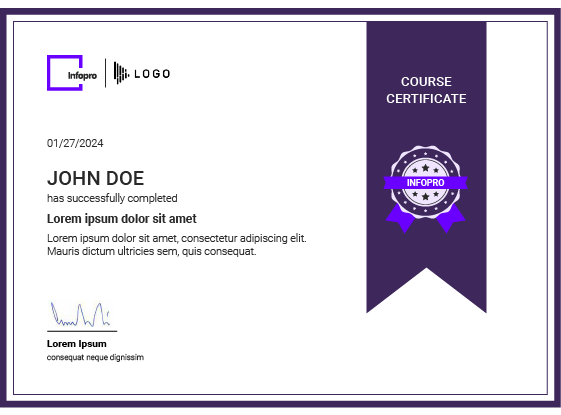Foundation of Digital Workplace This course provides an overview of the digital workplace concept, its importance in modern organizations, and the key components that make up a digital work environment.
- Define the concept of a digital workplace and its significance.
- Identify the key components and technologies in a digital workplace.
- Understand the benefits and challenges of digital transformation in the workplace.
- Recognize the impact of digital workplaces on productivity, collaboration, and work-life balance.
This course introduces participants to various tools and platforms commonly used in modern digital workplaces, providing a broad understanding of the digital ecosystem.
- Identify different categories of digital workplace tools (communication, collaboration, productivity, etc.).
- Understand the basic functions of popular digital workplace platforms.
- Recognize how different tools integrate to create a cohesive digital workspace.
- Evaluate the appropriateness of different tools for various work scenarios.
This course focuses on strategies for successfully transitioning to and thriving in a digital workplace, addressing common challenges and best practices.
- Develop strategies for managing the transition to a digital work environment.
- Identify and overcome common obstacles in adapting to digital tools and processes.
- Understand the importance of continuous learning in a rapidly evolving digital landscape.
- Create a personal plan for digital skill development and adaptation.
Microsoft 365 Overview This course provides a comprehensive introduction to the Microsoft 365 ecosystem, its core applications, and how they work together to enhance productivity and collaboration.
- Understand the structure and components of Microsoft 365.
- Navigate the Microsoft 365 interface and app launcher.
- Recognize how different M365 apps integrate and complement each other.
- Access and manage Microsoft 365 account settings and preferences.
This course focuses on mastering document creation, formatting, and collaboration features in Microsoft Word for professional use.
- Create and format professional documents using advanced Word features.
- Utilize templates and styles for consistent document design.
- Implement document collaboration and review features.
- Use advanced formatting tools for complex document layouts.
- Integrate other Office apps within Word documents.
This course covers the fundamentals of spreadsheet creation, data analysis, and visualization in Microsoft Excel.
- Create and format spreadsheets for various business purposes.
- Use formulas and functions for data calculation and analysis.
- Create basic charts and graphs for data visualization.
- Implement data validation and protection features.
- Use Excel tables and PivotTables for data organization and analysis.
This course teaches participants how to create engaging and professional presentations using Microsoft PowerPoint.
- Design visually appealing slides using PowerPoint themes and layouts.
- Create and format various types of content (text, images, charts, multimedia).
- Implement animations and transitions effectively.
- Use PowerPoint's collaboration features for team presentations.
- Deliver presentations confidently using presenter tools and features.
This course focuses on efficient email communication and schedule management using Microsoft Outlook.
- Manage emails effectively using folders, rules, and categories.
- Schedule and manage appointments, meetings, and tasks.
- Use Outlook's calendar sharing and scheduling assistant features.
- Implement strategies for achieving and maintaining "Inbox Zero".
- Utilize Outlook's integration with other Microsoft 365 apps.
This course covers cloud storage, file sharing, and collaboration using Microsoft OneDrive.
- Understand OneDrive's structure and its role in the Microsoft 365 ecosystem.
- Upload, organize, and sync files across devices using OneDrive.
- Share files and folders securely with internal and external users.
- Use OneDrive's co-authoring and version history features.
- Implement best practices for OneDrive file management and security.
Microsoft Teams FundamentalsThis course introduces participants to the basic features and navigation ofMicrosoft Teams, providing a foundation for effective collaboration in a digital workspace.
- Navigate the Microsoft Teams interface confidently.
- Create and manage teams and channels
- Use chat and video calling features for communication.
- Share and collaborate on files within Teams.
- Share and collaborate on files within Teams.
- Understand the integration of Teams with other Microsoft 365 apps.
Building on the fundamentals, this course explores advanced features of Microsoft Teams, enabling participants to maximize their productivity and collaboration potential.
- Utilize advanced meeting features like breakout rooms and live events.
- Implement and manage Teams apps and integrations.
- Create and use Teams templates for consistent team structures.
- Leverage Teams for project management and workflow automation.
- Analyze team activity and productivity using built-in analytics.
This course provides an introduction to Slack, covering its interface, basic features, and fundamental concepts of channel-based communication.
- Navigate the Slack interface and understand its core concepts.
- Create and manage channels for different purposes.
- Use direct messages and threads for effective communication.
- Share files and integrate basic apps within Slack.
- Customize notifications to manage information flow.
This advanced course delves into Slack's more complex features, focusing on workflow automation, advanced integrations, and strategies for managing large-scale Slack workspaces.
- Implement Slack workflows for process automation.
- Integrate advanced third-party apps and services with Slack.
- Use Slack's API for custom integrations (basic overview).
- Manage and organize large-scale Slack workspaces effectively.
- Utilize Slack's advanced search and analytics features.
This course focuses on best practices for professional communication in digital platforms, ensuring participants can interact effectively and respectfully in various digital contexts.
- Understand the nuances of tone and context in digital communication.
- Practice clear and concise writing for digital platforms.
- Use appropriate etiquette for different digital communication channels.
- Manage conflicts and misunderstandings in digital communications.
- Balance promptness with thoughtfulness in digital interactions.
This course teaches participants how to plan, conduct, and participate in effective virtual meetings and webinars across various platforms.
- Plan and structure effective virtual meetings and webinars.
- Use features like screen sharing, whiteboards, and polls effectively.
- Facilitate engaging discussions in a virtual environment.
- Troubleshoot common technical issues in virtual meetings.
- Apply best practices for virtual presentation and public speaking.
SharePoint Basics This course introduces participants to the structure, sites, and basic features of SharePoint, providing a foundation for effective document management and collaboration.
- Understand SharePoint's role in the Microsoft 365 ecosystem.
- Navigate SharePoint sites and libraries.
- Create and customize basic SharePoint sites.
- Upload, download, and share documents in SharePoint.
- Use SharePoint's search features to find information quickly.
This course focuses on advanced document management techniques in SharePoint, including version control, metadata, and collaboration features.
- Implement effective document organization strategies in SharePoint.
- Use version control and check-in/check-out features.
- Apply metadata and content types to improve document findability.
- Set up and manage document approval workflows.
- Utilize SharePoint's co-authoring and commenting features.
This course covers the creation and management of team sites, lists, and workflows in SharePoint for enhanced team collaboration.
- Create and customize team sites for specific project needs.
- Utilize SharePoint lists for task management and information tracking.
- Design and implement basic workflows for team processes.
- Use SharePoint's team calendar and newsfeed features
- Integrate SharePoint team sites with other Microsoft 365 apps.
This course provides an overview of intranet design principles, content management strategies, and techniques for driving user engagement in corporate intranets.
- Understand the key components and purposes of a corporate intranet.
- Plan and structure an effective intranet architecture.
- Implement best practices for intranet content management.
- Design user-friendly navigation and search experiences.
- Develop strategies for promoting intranet adoption and engagement.
Introduction to AI in Business This course provides an overview of AI applications in modern workplaces, focusing on how AI is transforming various business processes and decision-making.
- Understand basic AI concepts and their relevance to business.
- Identify current and potential AI applications in various business functions.
- Recognize the impact of AI on job roles and skill requirements.
- Understand the basic process of implementing AI solutions in business contexts.
- Assess the potential benefits and challenges of AI adoption in the workplace.
This course explores various AI-powered tools designed to enhance workplace productivity, including writing assistants, scheduling tools, and task automation platforms.
- Identify and evaluate different types of AI-powered productivity tools.
- Use AI writing assistants to improve content creation efficiency.
- Implement AI-powered scheduling and meeting management tools.
- Utilize AI for task prioritization and time management.
- Understand how to integrate AI tools into daily work routines.
This course addresses the ethical implications and limitations of AI in business contexts, focusing on responsible AI use and potential biases.
- Understand the ethical challenges associated with AI in the workplace.
- Identify potential biases in AI systems and their impacts.
- Recognize privacy and data protection concerns in AI applications.
- Understand the importance of transparency and explainability in AI systems.
- Develop strategies for responsible AI implementation and usage.
This course explores emerging AI technologies and their potential future impact on work, preparing participants for upcoming changes in the digital workplace.
- Identify key trends and emerging technologies in workplace AI.
- Understand the potential impact of advanced AI on various job roles and industries.
- Recognize the skills likely to be in demand in an AI-augmented workplace.
- Anticipate potential challenges and opportunities in future AI adoption.
- Develop a personal strategy for adapting to AI-driven workplace changes.
Basics of Data Analysis This course introduces fundamental concepts and techniques of data analysis, providing a foundation for data-driven decision making in the workplace.
- Understand the basic principles of data analysis and its importance in business.
- Identify different types of data and their appropriate uses.
- Apply basic statistical concepts to analyze data.
- Understand the data analysis process from collection to interpretation.
- Recognize common pitfalls and biases in data analysis.
This course focuses on using advanced Excel features for data manipulation, analysis, and basic visualization.
- Use Excel's data analysis tools and add-ins effectively.
- Create and interpret PivotTables and PivotCharts.
- Implement advanced Excel functions for data analysis (e.g., VLOOKUP, INDEX-MATCH).
- Perform basic statistical analysis in Excel.
- Create dynamic dashboards using Excel's features.
This course provides an introduction to Microsoft Power BI for creating interactive data visualizations and dashboards.
- Understand the basics of Power BI and its role in data visualization.
- Import and prepare data for analysis in Power BI.
- Create various types of visualizations using Power BI.
- Design interactive dashboards and reports.
- Share and collaborate on Power BI reports.
This course focuses on techniques for interpreting data and applying insights to make informed business decisions.
- Understand the principles of data-driven decision making.
- Interpret various types of data visualizations and reports.
- Apply critical thinking to data analysis results.
- Communicate data insights effectively to different audiences.
- Develop strategies for fostering a data-driven culture in teams and organizations.
Digital To-Do Lists and Task Management This course explores various digital tools for effective task organization and management, helping participants enhance their personal productivity.
- Evaluate and choose appropriate digital task management tools.
- Implement effective task organization strategies using digital tools.
- Use features like prioritization, categorization, and reminders effectively.
- Integrate task management tools with other productivity apps.
- Develop a personal system for managing tasks and projects digitally.
This course focuses on maximizing productivity through effective use of digital calendars and scheduling tools.
- Utilize advanced features of digital calendar applications.
- Implement effective time blocking and scheduling techniques.
- Use tools for coordinating schedules and booking meetings efficiently.
- Integrate calendar management with other productivity and communication tools.
- Develop strategies for balancing scheduled time and flexibility.
This course covers digital note-taking techniques and strategies for organizing information effectively in the digital workplace.
- Compare and select appropriate digital note-taking tools.
- Implement effective note-taking techniques for various scenarios (meetings, brainstorming, etc.).
- Organize and categorize digital notes for easy retrieval.
- Use features like tagging, searching, and linking in digital note-taking apps.
- Integrate notetaking with other productivity and project management tools.
This course provides strategies for efficient email handling and maintaining a clean inbox, improving overall productivity and reducing email-related stress.
- Implement the "Inbox Zero" methodology or similar email management strategies.
- Use email features and add-ons for efficient processing and organization.
- Create and manage email filters and rules for automatic organization.
- Develop effective email writing and responding habits.
- Balance email responsiveness with productivity and focus.
This course addresses techniques for maintaining focus and managing digital distractions in modern work environments.
- Understand the impact of digital distractions on productivity and wellbeing.
- Implement techniques for improving focus in digital work environments.
- Utilize digital tools and settings to minimize distractions.
- Develop healthy habits for device usage and digital consumption.
- Create a personalized strategy for balancing connectivity and focused work time.
Cybersecurity Basics for EmployeesThis course introduces fundamental concepts of cybersecurity in a digital workplace, helping employees understand their role in maintaining organizational security.
- Understand common cybersecurity threats in the workplace.
- Recognize the importance of cybersecurity in protecting organizational assets.
- Implement basic security practices in daily work routines.
- Identify signs of potential security breaches or suspicious activities.
- Understand and follow organizational cybersecurity policies.
This course focuses on best practices for secure authentication and account protection in digital environments.
- Understand the importance of strong, unique passwords.
- Implement effective password creation and management strategies.
- Use password manager tools securely and effectively.
- Understand and implement multi-factor authentication.
- Recognize and avoid common password-related security risks.
This course teaches participants how to identify and avoid common cyber threats and social engineering tactics, with a focus on phishing attacks.
- Understand the concept of phishing and its various forms.
- Identify common characteristics of phishing attempts.
- Implement strategies to verify the authenticity of digital communications.
- Know how to report suspected phishing attempts.
- Understand the potential consequences of falling for phishing attacks.
This course covers data protection regulations and privacy best practices in the context of digital workplaces, helping employees understand their responsibilities in safeguarding sensitive information.
- Understand key data protection regulations (e.g., GDPR, CCPA) and their implications for daily work.
- Identify different types of sensitive data in the workplace.
- Implement best practices for data handling, storage, and sharing.
- Recognize potential privacy risks in digital communication and collaboration tools.
- Understand and follow organizational data protection policies and procedures.
This course focuses on securing smartphones, tablets, and other mobile devices used for work purposes, addressing the unique challenges of mobile security in a digital workplace.
- Understand the specific security risks associated with mobile devices in the workplace.
- Implement basic security measures on personal and work-issued mobile devices.
- Use mobile device management (MDM) solutions effectively.
- Recognize and mitigate risks when using public Wi-Fi networks.
- Understand best practices for secure use of mobile apps and cloud services.
This course addresses the security aspects of social media use and maintaining a professional online presence, balancing personal expression with organizational security concerns.
- Understand the potential risks and benefits of social media use in a professional context.
- Implement privacy and security settings on various social media platforms.
- Recognize the impact of personal social media activity on professional reputation.
- Develop guidelines for maintaining a professional online presence.
- Understand organizational policies regarding social media use and representation.
This course focuses on securing smartphones, tablets, and other mobile devices used for work purposes, addressing the unique challenges of mobile security in a digital workplace.
- Understand the specific security risks associated with mobile devices in the workplace.
- Implement basic security measures on personal and work-issued mobile devices.
- Use mobile device management (MDM) solutions effectively.
- Recognize and mitigate risks when using public Wi-Fi networks.
- Understand best practices for secure use of mobile apps and cloud services.
This course addresses the security aspects of social media use and maintaining a professional online presence, balancing personal expression with organizational security concerns.
- Understand the potential risks and benefits of social media use in a professional context.
- Implement privacy and security settings on various social media platforms.
- Recognize the impact of personal social media activity on professional reputation.
- Develop guidelines for maintaining a professional online presence.
- Understand organizational policies regarding social media use and representation.
This course teaches employees how to recognize, report, and respond to various security incidents in the digital workplace, emphasizing the importance of prompt and appropriate action.
- Identify different types of security incidents that may occur in a digital workplace.
- Understand the proper channels and procedures for reporting security incidents.
- Learn basic incident response steps to mitigate immediate risks.
- Recognize the importance of documenting security incidents.
- Understand the role of various stakeholders in the incident response process.
This course explores emerging cybersecurity threats and trends, preparing employees to adapt to the evolving digital security landscape.
- Understand current trends and emerging threats in cybersecurity.
- Recognize the potential impact of new technologies on workplace security.
- Learn about advanced persistent threats (APTs) and their implications.
- Understand the basics of AI and machine learning in cybersecurity.
- Develop strategies for staying informed about new security risks and best practices.
This final course focuses on fostering a security-conscious culture within organizations, emphasizing the role of each employee in maintaining overall digital security.
- Understand the concept of security culture and its importance in organizations.
- Recognize personal responsibilities in maintaining workplace security.
- Learn techniques for promoting security awareness among colleagues.
- Understand the balance between security measures and workplace productivity.
- Develop strategies for continuous learning and adaptation in digital security.
An excellent course. Mastering the digital workplace equipped me with the practical skills to optimize my digital work environment. The strategies and hands-on techniques shared were incredibly valuable. I now feel more efficient and confident in managing tasks remotely—a must-take for anyone looking to boost their digital skills.




